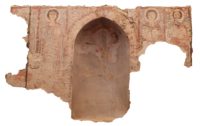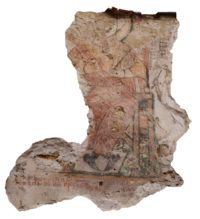 Medieval Coptic murals have been discovered on the walls of the Monastery of Saint Bishoy at Wadi El Natrun in the Nitrian Desert of northern Egypt. The monastery was damaged by flooding in 2015 and experts from the Ministry of Antiquities have been working since then to restore it. The frescoes were discovered under a layer of modern mortar. They were painted between the 9th and 13th centuries and depict saints and angels. Some of the frescoes have Coptic inscriptions underneath them.
Medieval Coptic murals have been discovered on the walls of the Monastery of Saint Bishoy at Wadi El Natrun in the Nitrian Desert of northern Egypt. The monastery was damaged by flooding in 2015 and experts from the Ministry of Antiquities have been working since then to restore it. The frescoes were discovered under a layer of modern mortar. They were painted between the 9th and 13th centuries and depict saints and angels. Some of the frescoes have Coptic inscriptions underneath them.
“The most distinguished paintings are those on the western and eastern walls of the church,” [Ministry of Antiquities scientist Ahmed El-Nemr] said, describing the painting on the western wall as showing a woman named as Refka and her five sons, who were martyred during the persecution of Christians by the Roman empire.
The painting on the eastern wall depicts three saints and an archangel, and features Coptic writings below.
El-Nemr explained that when restorers removed the modern additions they stumbled upon the ambon, an elevated platform that is a feature of many orthodox churches.
The newly discovered ambon is made of mud-brick covered with a layer of mortar and decorated with a red cross.
Some geometric drawings, crosses and lettering were also found in various parts of the church.
The age of the paintings, inscriptions and the ambon are of particular significance because they date to a period when the monastery church was undergoing extensive alterations. Historical and religious records document extensive changes to the architecture and decoration of Saint Bishoy’s in 840 AD, during the Abbasid era, and in 1069 AD, during the Fatimid caliphate. Archaeologists hope the newly discovered features may elucidate some the church’s original design and fill in some of the blanks in the timeline of its construction phases from antiquity into the modern era.
The monastery was founded in the 4th century by Saint Bishoy (320 – 417 A.D.), a deeply devout monk who, like many of his time, emulated the ascetics and lived in the desert wilderness. His humility, dedication to prayer, hard work and the poor earned him a following of thousands who flocked to live in mountain caves surrounding his cave in what is now Deir el-Surian, about a third of a mile from the Monastery of Saint Bishoy.
 According to Coptic hagiographies, Bishoy’s humbleness netted him at least two personal meetings with the risen Christ. The first time he was washing the feet of passing strangers, as was his wont, when he spotted crucifixion scars on the feet of one of them and realized he’d just washed Jesus’ feet. Another time he offered to carry an old ailing monk up the mountain on his back only to find the ailing old man was Jesus in disguise (again). Jesus told him then that because he had kept his body pure through his asceticism and used it only to serve the poor, lowly and God, including carrying God on its back up a mountain, Bishoy’s body would never decay.
According to Coptic hagiographies, Bishoy’s humbleness netted him at least two personal meetings with the risen Christ. The first time he was washing the feet of passing strangers, as was his wont, when he spotted crucifixion scars on the feet of one of them and realized he’d just washed Jesus’ feet. Another time he offered to carry an old ailing monk up the mountain on his back only to find the ailing old man was Jesus in disguise (again). Jesus told him then that because he had kept his body pure through his asceticism and used it only to serve the poor, lowly and God, including carrying God on its back up a mountain, Bishoy’s body would never decay.
Jesus kept his promise. When Bishoy’s body was moved to the Wadi El Natrun monastery in 841 A.D. by order of Saint Joseph I of Alexandria, 52nd Pope of Alexandria, it was indeed found to be incorrupt. The saint’s body lies in the monastery church to this day, and according to witnesses is still incorrupt.
Thank you again, for an extraordinary post which I would never have known about except for your blog. Such an exceptional testimony.
I’ve not been getting the daily email alerts. Love your site and don’t want to miss a single one.
Particularly the last painting with the Gothic battle Axe and what appears to be Refka and her five sons, martyred on the Roman empire’s lap, is rather uncommon, I reckon.
The Coptic letters are obviously derived (mainly) from Greek and (egyptian) Demotic. The “Arif Megintia Tepa/Se” bit (on the left), seems to be Coptic AND Greek, but does not make sense to my completely unskilled eye at all
What exactly do the inscriptions say ?
Very cool! Thank you.